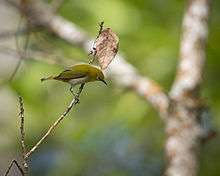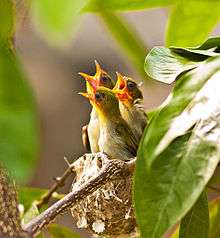Mountain white-eye
| Mountain white-eye | |
|---|---|
 | |
| In Indonesia | |
| Scientific classification | |
| Kingdom: | Animalia |
| Phylum: | Chordata |
| Class: | Aves |
| Order: | Passeriformes |
| Family: | Zosteropidae |
| Genus: | Zosterops |
| Species: | Z. montanus |
| Binomial name | |
| Zosterops montanus Bonaparte, 1850 | |

The mountain white-eye or oriental white eye (Zosterops montanus) is a species of bird in the family Zosteropidae. It is found in islands of Malesia, i.e. Indonesia and the Philippines, except Borneo. It is an introduced species in south-west China and parts of Sudan
Omnivorous birds, depending on location rely on either nectar from flowering trees such as the Myrica javanica[2] or insects. Referred to as soft billed birds
Description
Their size ranges from 5–15 cm (about 6 inches), their average weight within 9.4–12.6 g.
Olive-yellow headed bird with white eye rings, black eyes, black streaks from eyes to beak, vibrant yellow throat and buff grey underparts, yellow undertail coverets and wings which are yellow with grey edges. Due to their nectar diet, they have sharp, thin beaks and a brush shaped tongue. They have little sexual dimorphism, the main difference being males have a very distinct call whereas females are typically silent.
Nesting and behavior
Sociable birds which create large flocks that feed and travel together, only separate during their nesting season in February through September, peaking in mid April. Male white-eye use spiderwebs, moss, and soft vegetation to make cup shaped nests in crooks of trees, usually nesting several times a breeding season. A typical breeding female will produce two to four pale blue eggs per nest.[3] White-eye eggs hatch in roughly 10 days. Both male and female birds assist in brooding for an additional 10 days before the chicks fledge. Mountain white-eyes are known to breed in their resident habitat with no migration, dwelling mainly in subtropical and tropical Malasian mangrove forest regions and waste lands.[4]
Population and distribution
Not much is known about their population numbers due to their wide habitat range and near indistinguishable appearance from the Everett's white-eye, although their numbers are speculated to be stable.[5] Mountain white eyes are also utilized and bred as exotic pets,[6] leading some to worry about their numbers due to poaching and trapping [7]
References
| Wikimedia Commons has media related to Zosterops montanus. |
- ↑ BirdLife International. (2016). Zosterops montanus. The IUCN Red List of Threatened Species doi:10.2305/IUCN.UK.2016-3.RLTS.T22714075A94400475.en
- ↑ "Mountain White-eye (Zosterops montanus)". www.hbw.com. Retrieved 2017-06-17.
- ↑ ""White-eyes" Bird Genus Zosterops". www.beautyofbirds.com. Retrieved 2017-06-17.
- ↑ "Zosterops montanus (Mountain White-eye)". www.iucnredlist.org. Retrieved 2017-06-17.
- ↑ "Mountain White-eye (Zosterops montanus) – BirdLife species factsheet". datazone.birdlife.org. Retrieved 2017-06-17.
- ↑ "White-eyes or Zosterops". www.petinfoclub.com. Retrieved 2017-06-17.
- ↑ Khoon, Khong Tuck. "Pictures and description of the White-eyes birds". www.malaysianbirds.com. Retrieved 2017-06-18.
